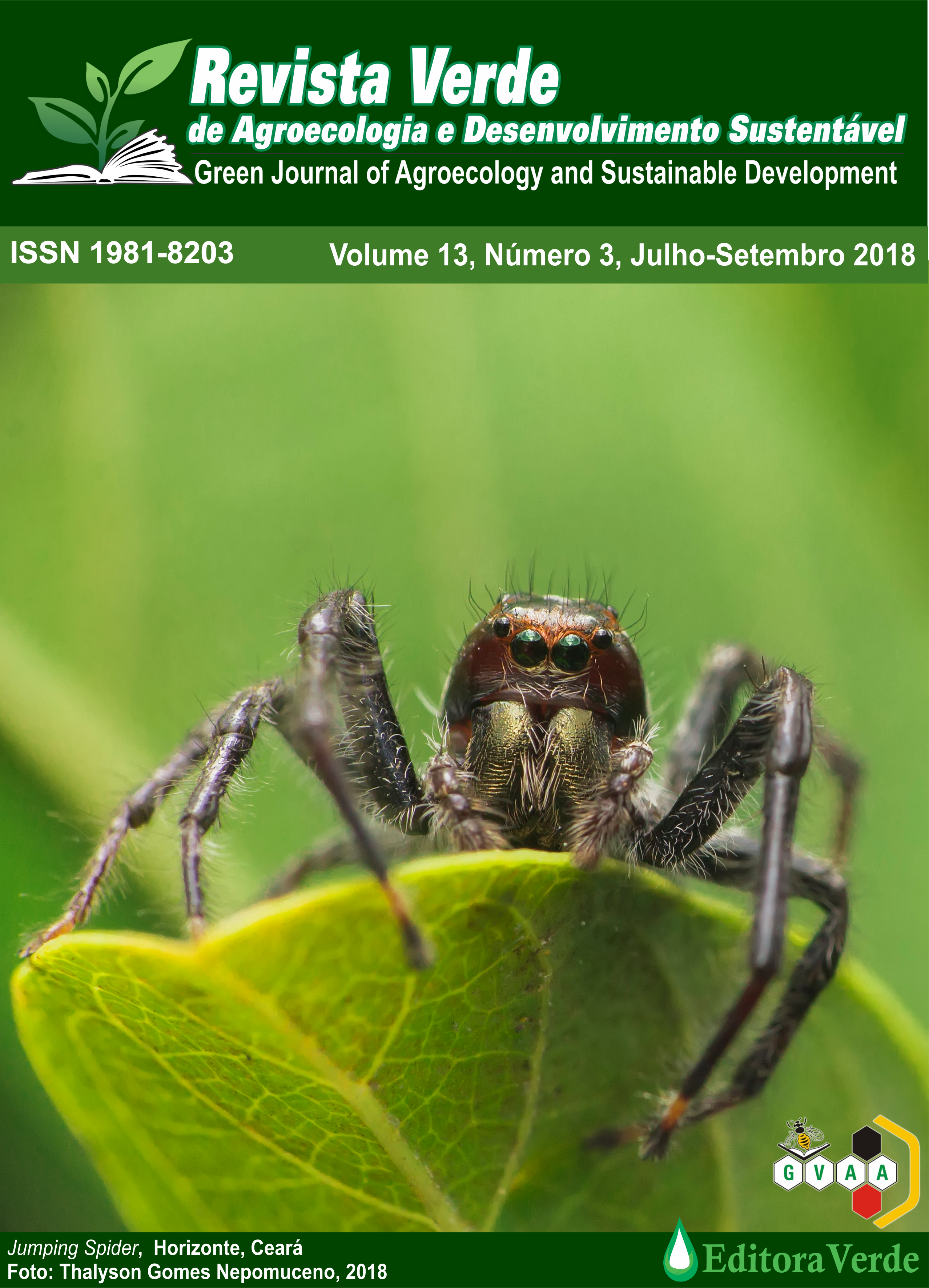Mimosa L. (Fabaceae: Caesalpinioideae) in the herbarium Northern Agronomic Institute of Embrapa Eastern Amazonia
DOI:
https://doi.org/10.18378/rvads.v13i3.5481Keywords:
Herbalists, Conservation, Scientific Collection, Database.Abstract
The biological collections are evidence of the biodiversity and requisit instrument for several studies and, in this context, the Herbarium of Embrapa Amazônia Oriental was indexed by the Index Herbariorum under the acronym IAN, because at the time of its creation Embrapa was called Instituto Agronômico do Norte, contains a wide diversity of gender Mimosa L., which shows notable economical potential by having a lot of applications in folk medicine, recovery of degraded areas, environmental services, animal food, timber and other utilities. This present study aims to realize the database collection, informatization and availability of Mimosa L. genus, in the herbarium IAN collection of Embrapa Oriental Amazon, highlighting the relevance of the collection and the diversity of existent samples. The data which contains the genus were extracted from the Herbarium IAN database with the software BRAHMS and compared with the data contained in the exsiccates. In this way, it is possible to repair, add data and images that are not found in the database. After verification of the data and the quality of the images, the information become available on internet. So, there were obtained 683 gender Mimosa samples, with presence of 176 species collected in several places, and the estate of Pará being the most representative among the others states. Thus, were verified that near 93% of Mimosa data collection from Herbarium IAN is computerized and with its respective scanned images;86% of all Mimosa material owned to the IAN is available on the software Herbário Virtual IAN. The present study also points out the importance of the collection digital processing and availability, which provide agility and accessibility for scientific institutions and the communities in general.Downloads
References
BARNEBY, R. C. Sensitivae censitae: a description of the genus Mimosa Linnaeus (Mimosaceae) in the New World. Mem N Y Bot Gard 65, p. 5-24, 1991
BFG. Growing knowledge: an overview of Seed Plant diversity in Brazil. Rodriguésia, Rio de Janeiro, v.66, n.4, p. 1085-1113, 2015.
BORGES, L. M. Filogenia e sistemática de Mimosa L.: M. ser. Pachycarpae Benth. e M. ser. Setosae Barneby. 2014. 269f. Tese (Doutorado em Botânica). Instituto de Biociências, Universidade de São Paulo. 2014.
BORGES, L. M. Mimosoideae na Serra do Cipó, Minas Gerais e análise da variabilidade morfológica de Mimosa macedoana Burkart. 2010. Dissertação (Mestrado em Botânica) - Instituto de Biociências, Universidade de São Paulo, São Paulo, 2010.
CARVALHO, P. E. R. Sabi, Mimosa caesalpiniifolia. Circular Técnica-Embrapa Florestas, n. 135, 2007. p. 2-7.
CARVALHO, P. E. R. Maricá-Mimosa bimucronata. Circular Técnica-Embrapa Florestas, n. 94, 2004.p.1-6
CARVALHO, P. E. R. Espécies florestais brasileiras: recomendações silviculturais, potencialidades e uso da madeira. Brasil: EMBRAPA-CNPF/SPI, 1994.
CORADIN, L.; SIMINSKI, A.; REIS, A. Espécies nativas da flora brasileira de valor econômico atual ou potencial. Brasília: Ministério do Meio Ambiente, 2011. p. 478 – 493, 656 – 662.
COSTA, J. C. M.; LUCAS, F. C. A.; GOIAS, M. A. F.; LEÂO, V. M.; LOBATO, G. J. M. Herbário virtual e universidade: biodiversidade vegetal para ensino, pesquisa e extensão. Scientia Plena, v.12, n.6, 2016.
COUTINHO, A. P. S. Revisão taxonômica e estudos filogenéticos de Mimosa L. sect. Calothamnos Barneby (Leguminosae-Mimosoideae). 2009. 334 f. Tese (Doutorado em Ciências). Universidade de São Paulo. São Paulo. 2009.
DOURADO, D. A. O.; CONCEIÇÃO, A.S.; SANTOS-SILVA, J.. O gênero Mimosa L.(Leguminosae: Mimosoideae) na APA Serra Branca/Raso da Catarina, Bahia, Brasil. Biota Neotropica, Campinas, v.13, n.4, p. 225-240, 2013.
DUTRA, V. F. Diversidade de Mimosa L. (Leguminosae) nos campos rupestres de Minas Gerais: Taxonomia, distribuição geográfica e filogeografia. 2009. 294 f. Tese (Doutorado em Botânica). Universidade Federal de Viçosa. Viçosa. 2009.
LEWIS, G.; SCHRIRE, B.; MACKINDER, B.; LOCK, M. Legumes of the World. Richmond, UK: Royal Botanic Gardens, Kew, 2005. p. 183
LORENZO, H.; MATOS, F. J. A. Plantas medicinais do Brasil: Nativas e exóticas cultivadas. Nova Odessa: Instituto Plantarum, 2002. P. 295.
LPWG - The Legume Phylogeny Working Group. A new subfamily classification of the Leguminosae based on a taxonomically comprehensive phylogeny. Taxon 66. p. 44-77, 2017.
NASCIMENTO, I. A. do; BRAZ-FILHO, R.; CARVALHO, M. G. de; MATHIAS, L.; FONSECA, F. A. Flavonoides e outros compostos isolados de Mimosa artemisiana Heringer e Paula Química Nova, v. 35, n. 11, p. 2159-2164, 2012.
PEIXOTO, F. L. O Processo de Informatização de Herbários: Estudo de Caso. 79f. Dissertação (Mestrado em Botânica) – Escola Nacional de Botânica do Instituto de Pesquisas do Jardim Botânico do Rio de Janeiro. Rio de Janeiro, 2005.
PEREIRA, A. P. O que é XML. Disponível: https://www.tecmundo.com.br/programacao/1762-o-que-e-xml-.htm. Acessado em 21/02/2017.
SILVA, J. S. Filogenia, estudos micromorfológicos e revisão taxonômica de Mimosa ser. Leiocarpa benth. (Leguminosae – Mimosoideae). 309 f. Tese (Doutorado em Biologia Vegetal). Universidade Estadual de Campinas, Campinas. 2013.
SIMON, M. F.; PROENÇA, C. Phytogeographic patterns of Mimosa (Mimosoideae, Leguminosae) in the Cerrado biome of Brazil: an indicator genus of high-altitude centers of endemism? Biological Conservation, v.96, n.3, p.279-296, 2000.
SOUZA, H. J. R. de; MARTINS-DA-SILVA, R. C. V.; FILER, D. L.; XAVIER-JUNIOR, S. R.; FOURO, A. M. M. Dados do Herbário IAN da Embrapa Amazônia Oriental / Belém, PA: Embrapa Amazônia Oriental, 2013. 43 p.: il.; 15 cm x 21 cm. – (Documentos / Embrapa Amazônia Oriental, ISSN 1983-0513; 392). p. 9 - 10.











